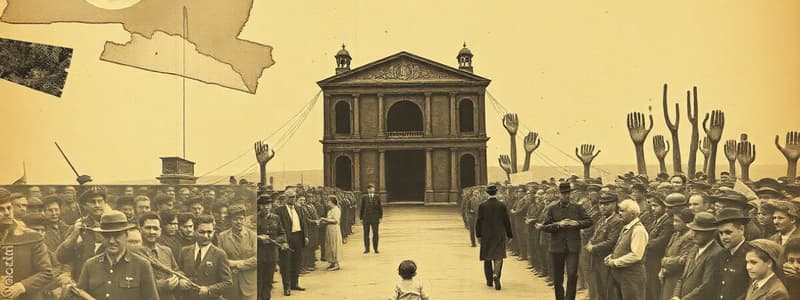Podcast
Questions and Answers
Which sentence correctly illustrates the use of past simple tense?
Which sentence correctly illustrates the use of past simple tense?
- She was walking to the store when it started to rain.
- He was sleeping during the movie.
- I played soccer yesterday at the park. (correct)
- They had dinner while watching the game.
What grammatical form is primarily used to construct the past continuous tense?
What grammatical form is primarily used to construct the past continuous tense?
- was/were + -ing form of the verb (correct)
- had + past simple form of the verb
- was/were + past participle of the verb
- was/were + base form of the verb
In which of the following sentences is the past continuous tense used correctly?
In which of the following sentences is the past continuous tense used correctly?
- He was watching TV and then he went to sleep.
- She cooked dinner and then cleaned the kitchen.
- They went to the beach while it was raining.
- I was reading when the lights went out. (correct)
Which of these sentences combines the past simple and past continuous tenses effectively?
Which of these sentences combines the past simple and past continuous tenses effectively?
Which of the following sentences contains a common error in the use of past tense?
Which of the following sentences contains a common error in the use of past tense?
Flashcards
Past Simple Tense
Past Simple Tense
Used to describe completed actions or states in the past. It expresses a single, completed action and indicates a specific time in the past. It is often used with adverbs like yesterday, last week, etc., and forms include verbs ending in -ed (e.g., walked, played, studied) or unique past forms (e.g., went, had).
Past Continuous Tense
Past Continuous Tense
Used to describe ongoing actions at a specific time in the past. It emphasizes the duration of an activity, often using expressions like 'while' or 'during.' It's formed using the past tense of 'to be' (was/were) + the -ing form of the verb.
Distinguishing Past Simple and Past Continuous
Distinguishing Past Simple and Past Continuous
The past simple is used for discrete actions in the past, while the past continuous describes actions in progress. If two actions happened, one ongoing and one happening at that moment, the ongoing action uses the past continuous, and the other uses the past simple.
Common Errors in Past Tenses
Common Errors in Past Tenses
Signup and view all the flashcards
Choosing the Right Tense
Choosing the Right Tense
Signup and view all the flashcards
Study Notes
Past Simple Tense
- Used to describe completed actions or states in the past.
- Expresses a single, completed action.
- Indicates a specific time in the past.
- Often used with adverbs like yesterday, last week, a few days ago, in 2001, etc.
- Forms of the past simple usually involve a verb ending in -ed (e.g., walked, played, studied) or use a past tense form of the verb (e.g., was/were, went, had).
- Examples:
- I went to the cinema yesterday.
- They lived in London for five years. (Note: "lived" describes a state over a period, not a single action; it is still past simple)
- She ate a big pizza last night.
- Irregular verbs have unique past tense forms (e.g., go – went, eat – ate, see – saw, drink – drank, become – became. Memorizing irregular verbs is crucial).
Past Continuous Tense
- Used to describe actions in progress at a specific time in the past.
- Shows an activity that was ongoing during a period in the past.
- Implies the activity may have continued over an amount of time, rather than being a single moment.
- Often used with expressions that emphasize duration (e.g., while, during, from...to...).
- Forms of the past continuous use the past tense of "to be" (was/were) + the -ing form of the main verb (e.g., was walking, were playing, was eating).
- Examples:
- I was studying when the phone rang.
- They were playing football in the park at 3 pm.
- I was working from home during the pandemic.
Distinguishing Between Past Simple and Past Continuous
- Use past simple for completed actions and past continuous for actions in progress.
- Use past simple for a single action in the past; use past continuous for an action that happened over a period of time or simultaneously with another.
- If two actions happened in the past, and one was ongoing at the time the other happened, the ongoing action will use the past continuous, and the other action will use the past simple.
- Examples illustrating the differences:
- Past Simple: The teacher gave the test and then the bell rang. (Two separate events)
- Past Continuous: While Sarah was eating, the phone rang. (One action was in progress while another happened)
- Past Simple: She watched the film and then went to bed. (Two completed actions)
- Past Continuous: She was watching TV when the doorbell rang. (Watching TV—ongoing action, door bell ringing—one moment)
Common Errors and Confusions
- Confusing the two tenses when describing multiple past events.
- Using the correct tense to describe a single past event.
- Misunderstanding when to use the past simple versus the past continuous. Important: Consider the duration of the action.
- Confusing irregular verbs for other verbs (memorization of irregular verbs is key).
How to Use the Past Simple and Continuous Together
- To show actions happening at the same time:
- While she was walking home, she saw a dog.
- To show an action interrupted by another:
- While he was studying, the phone rang.
- To show an action continuing in the past up to a specific point:
- I was working from home until 6 PM.
Summary Table (Helpful for Review)
| Tense | Description | Example | Key Features |
|---|---|---|---|
| Past Simple | Completed action or state | I went to the store. | Single, completed action; specific time |
| Past Continuous | Action in progress at a specific time | I was playing games. | Ongoing action; duration; often with "while," "during" |
Studying That Suits You
Use AI to generate personalized quizzes and flashcards to suit your learning preferences.
Description
This quiz covers the Past Simple and Past Continuous tenses in English grammar. Explore how to describe completed actions and actions in progress during specific past times. Test your knowledge with examples and irregular verb forms.




